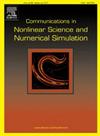多冗余机械手系统的分布式区域跟踪编队控制:一种势能方法
IF 3.4
2区 数学
Q1 MATHEMATICS, APPLIED
Communications in Nonlinear Science and Numerical Simulation
Pub Date : 2025-06-11
DOI:10.1016/j.cnsns.2025.109009
引用次数: 0
摘要
在本研究中,我们解决了协调一组冗余机器人操纵系统的挑战,每个系统都由拉格朗日动力学控制。目标是在指定的动态区域内保持稳定的队形,同时避免运动奇点。所设计的控制算法的关键特点是提出了一个全分布式控制器。该控制器采用两个分布式状态观测器,并结合局部形成势函数和区域势函数。在控制律中引入编队梯度函数和区域梯度函数,进一步协调多目标任务。这为区域协调提供了一个分析框架。仿真算例验证了该分布式控制算法的有效性。本文章由计算机程序翻译,如有差异,请以英文原文为准。
Distributed region tracking formation control for multiple redundant robot manipulator systems: A potential energy approach
In this research, we tackle the challenge of coordinating a group of redundant robot manipulator systems, each governed by Lagrangian dynamics. The goal is to maintain a stable formation within a specified dynamic region while avoiding kinematic singularities. The key feature of the designed control algorithm is the proposal of a fully distributed controller. This controller utilizes two distributed state observers and combines local formation potential functions with regional potential functions. The new control method introduces formation gradient functions and regional gradient functions into the control law to further coordinate the multi-objective tasks. This provides an analytical framework for regional coordination. Simulation examples are conducted to verify the effectiveness of this innovative distributed control algorithm.
求助全文
通过发布文献求助,成功后即可免费获取论文全文。
去求助
来源期刊

Communications in Nonlinear Science and Numerical Simulation
MATHEMATICS, APPLIED-MATHEMATICS, INTERDISCIPLINARY APPLICATIONS
CiteScore
6.80
自引率
7.70%
发文量
378
审稿时长
78 days
期刊介绍:
The journal publishes original research findings on experimental observation, mathematical modeling, theoretical analysis and numerical simulation, for more accurate description, better prediction or novel application, of nonlinear phenomena in science and engineering. It offers a venue for researchers to make rapid exchange of ideas and techniques in nonlinear science and complexity.
The submission of manuscripts with cross-disciplinary approaches in nonlinear science and complexity is particularly encouraged.
Topics of interest:
Nonlinear differential or delay equations, Lie group analysis and asymptotic methods, Discontinuous systems, Fractals, Fractional calculus and dynamics, Nonlinear effects in quantum mechanics, Nonlinear stochastic processes, Experimental nonlinear science, Time-series and signal analysis, Computational methods and simulations in nonlinear science and engineering, Control of dynamical systems, Synchronization, Lyapunov analysis, High-dimensional chaos and turbulence, Chaos in Hamiltonian systems, Integrable systems and solitons, Collective behavior in many-body systems, Biological physics and networks, Nonlinear mechanical systems, Complex systems and complexity.
No length limitation for contributions is set, but only concisely written manuscripts are published. Brief papers are published on the basis of Rapid Communications. Discussions of previously published papers are welcome.
 求助内容:
求助内容: 应助结果提醒方式:
应助结果提醒方式:


